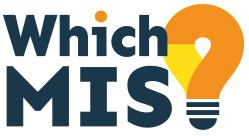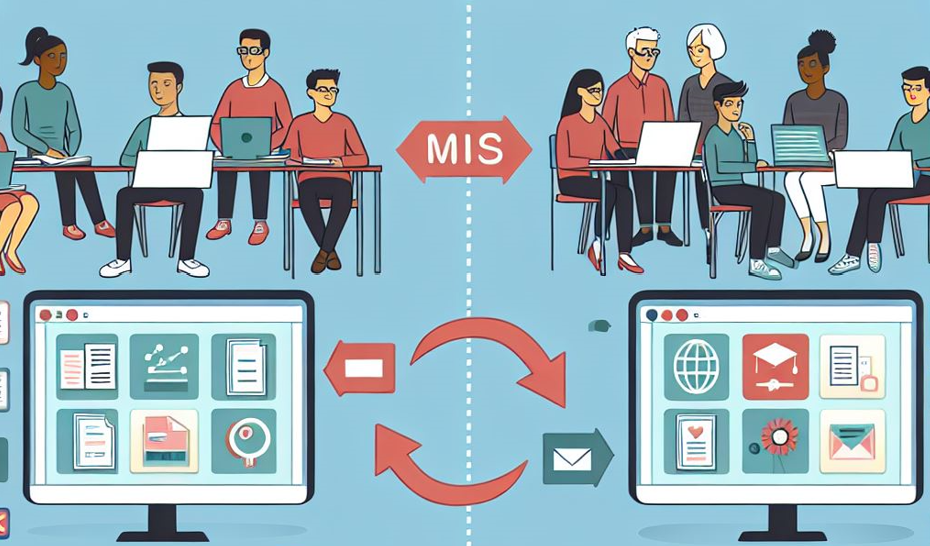We asked all MIS providers the same question – “With the new academic year recently started, and schools switching MIS more than ever, can you tell us about your migration services & timescales? ”
Here at WhichMIS, we appreciate that a number of schools and MATS are considering the ever growing churn in the MIS sector, so if you are thinking of changing your MIS, please read our Key Considerations when thinking of changing your MIS.
As usual, we asked all MIS providers the same question (above) and we list below all the responses we have received to date, in alphabetical order only. To date, we have received the following responses:

Schools have three options for migrating their data to Bromcom MIS:
- Managed migration – our team migrates the data for you
- Self-service migration – you upload your data to our self-service data migration portal
- Manual data entry – you manually enter staff and student data on a blank system
How long it takes a school to migrate depends on the MIS provider they’re with and the kind of school they are. However, our estimates for schools to switch to Bromcom (not just migration but from discovery call with the onboarding team to the MIS going live) are as follows:
- A primary school with SIMS will take around four to seven weeks
- A secondary school with SIMS will take around six to 12 weeks
- Any school with Arbor will take a minimum of eight weeks
- Any school with RM Integris will take a minimum of eight weeks
Migrating from Arbor will involve customers firstly requesting a copy of their school’s data. Once they have provided them with a backup of the data, Bromcom will carry out a managed migration.
As we do not get data backups with RM Integris, we use its third-party APIs to interrogate the data.
This is limited to the API access to data that can be migrated.
This is a self-service migration where the customer runs the migration through Bromcom’s migration portal.
In addition, any migration from iSAMS, SchoolPod, SchoolBase systems and Horizons requires manual data entry that a school will need to carry out.

Our migration services are designed to ensure a smooth transition to Compass.
Schools migrate over a term, starting with an initial data migration, followed by a “sandpit” period where they can explore their new portal.
During this phase, we import a subset of their data, allowing staff to familiarise themselves with the system and adjust processes before going live.
Our approach is divided into three stages:
- initial migration,
- training and ‘sandpit’ period,
- final migration to go live.
Throughout the process, we emphasise data cleansing, so schools start using their new MIS with clean, accurate data.
Something that we pride ourselves on and have had great feedback from customers is our training.
We tailor it to specific roles, featuring a combination of webinars and school-specific consultations to ensure every team member is fully prepared.

Migrating school data from your Management Information System (MIS) to another is a critical task. It requires a sharp focus on details and a recognition that schools don’t pause their operations just because a migration project is in progress. Ensuring a seamless transition while the school continues to run smoothly is key.
Before a school even begins to move data or commits to a new MIS, there are three essential questions that should be addressed to avoid headaches down the line.
1. Are we making the right decision to switch MIS?
This may sound obvious, but it’s a question worth asking seriously. A surprising number of schools switch to a new MIS only to return to their original system shortly after. This can happen due to unforeseen challenges, misaligned expectations, or simply realising the old system better met their needs. So, take the time to weigh the pros and cons of the move and ensure all stakeholders are on board before proceeding.
2. Is our data ready to move?
The quality of your data plays a huge role in how smoothly the migration will go. Often, schools need to address long-standing data issues, that they have previously ‘lived with’ when preparing for a migration. Take the opportunity, pre-migration, to clean up redundant or incorrect data. Addressing these problems beforehand will shorten the migration process, minimise potential issues, and improve how well the new MIS serves your school.
3. Can our current MIS easily extract all the data we need?
The ease of data extraction from your existing MIS has a direct bearing on the effort to migrate. If your current MIS offers a well-documented, consistent way to export all your data (ideally through an open Application Programming Interface), the migration process will be far smoother. Systems that rely on manual reports and data extracts can significantly slow down the process, so check how comprehensive and well-documented these extraction methods are in advance.
Ready to Move to SIMS? Here’s What Happens Next
Once you’ve confirmed the decision to switch MIS, prepared your data, and confirmed that your current system can provide the necessary data extracts, the next step in the migration begins.
At ESS, we start with a customer scoping meeting. This is where we work with you to outline the migration process and agree on timelines that won’t overwhelm your staff.
Stage 1: Data Collection
The first step is taking a copy of your data. If this involves generating reports and extracts, we’ll provide you with predefined report templates that can be used within your current MIS. Our team will support you through this process to ensure everything is gathered correctly.
Stage 2: Data Formatting
Once you’ve sent us the reports, our implementation team will step in to review and resolve any key data issues before importing everything into SIMS. We work closely with your team to ensure everything is formatted correctly, so you can hit the ground running with your new system.
Stage 3: Data Verification
After the data has been imported into SIMS, we provide access to your school’s version of the system. This is the time for key staff members to verify that everything has been migrated as expected before the system goes live. Parallel to this, your school can participate in familiarisation, training, and pre-onboarding activities.
How Long Does the Process Take?
The timeline for the migration depends on what works best for your school. While it’s possible to complete everything in as little as 8-10 working days, schools often choose to spread out the tasks to better accommodate their day-to-day operations. If your current MIS allows for automated data extraction, the process can move even faster. However, flexibility is key, and we’re committed to working within your school’s schedule to make the transition as smooth as possible.
Switching to SIMS doesn’t have to be overwhelming. By planning carefully, addressing data issues early, and choosing the right partner for your migration, you can make the process more efficient and less disruptive to your school’s daily operations.

As an MIS provider that has retained a small-business family feel over the years, ensuring a standout experience from day one is of paramount importance.
Furlong migration services averagely take 3-months to complete but our team have been known to expedite this period to just a couple of weeks in more urgent situations.
During this process, our support and professional services teams create the new database, migrate existing data, configure all areas of the MIS to align with customisation requests and provide initial user training.
We understand that a ‘one-fits-all’ approach to MIS usage is impossible which is why for every new customer, we create a bespoke migration plan complete with transparent timescales.
Schools are kept informed during the entire process which takes the stress away from switching MIS platforms.
This means with Furlong, you can have a new MIS configured in a matter of weeks.

We understand the importance of a smooth and timely migration process, especially as schools prepare for the new academic year.
Recently, we successfully migrated a school to HUBmis within just two weeks, demonstrating our commitment to efficiency and customer satisfaction.
Our approach to migration is highly collaborative, with timescales tailored to each school’s unique needs.
We establish clear and realistic milestones for onboarding and provide a dedicated migration pack for each school, ensuring a seamless transition to HUBmis.

We are currently testing our migration processes with several pilot schools so at the early stages, but currently we have a clear approach and hope to make this as painless as possible for schools in the future.
As GO 4 Schools modular is already used by schools we can also offer a phased migration which allows a school to move towards the GO 4 Schools MIS at a pace that works for them.
For example, they can opt to move their assessment and progress reports to GO 4 Schools MIS first, then their attendance and behaviour, and so on.
This can help with implementation to fit in with school calendars, e.g. where support staff are in school over the summer, INSET days for teaching staff, etc.
During a phased migration, all other features must remain managed in the outgoing MIS until the migration is completed, which would be an agreed date between the start of the SaaS Service Period and the end of the current MIS contract. In essence a school can move to modular GO 4 Schools initially for assessment, attendance, behaviour, homework etc and then select when they want to switch to our MIS.

Veracross employs a highly structured approach to implementation and data migration, utilising a team of product-area experts to support schools throughout each phase of implementation, from project management, internal change management, system configuration, and testing/UAT. All timelines and to-dos are managed within Veracross Community, our dedicated project management tool.
Veracross data migration comprises data migration planning, retrieval of initial data, drop down data mapping, and loading of data and validation.
Thorough planning ensures that data precedence rules are set, scope of data is understood, and basic export instructions are provided.
Veracross Implementation Engineers and Technicians will assist in helping schools to use our data import tools to import prior system data.
Implementation timelines will vary dependent on the number of modules implemented and the approach each school would like to take.
It is common for schools to adopt a phased implementation approach over the course of an academic year and our implementation approach is structured in such a way that key school staff can implement Veracross alongside their day-to-day roles without significant additional weekly time commitment.
As Veracross is a feature-rich MIS we ensure each implementation is approached on a case-by-case basis to minimise disruption for all our schools.
Procurement of a new Management Information System (MIS) is a significant undertaking for any school or Multi Academy Trust (MAT) and professional advice at every step of this journey is paramount. There are a multitude of considerations to be made – everything from ‘why the need for change’, through the functionality, training and support required for the new system and on to the budget and procurement issues.
The team at WhichMIS have all been involved in the educational technology sector for many years, both within technology providers but also as school governors and MAT Trustees. They are experienced in specification for new technology, procurement and project management as well as having successful tender and bid experience across a number of sectors.
We offer a range of procurement help and advice – details of which can be found here.

